The Office of Hawaiian Affairs (OHA) was established during the 1978 Constitutional Convention, Hawai‘i State Constitution (Article XII). Chapter 10 of the Hawai‘i Revised Statutes (HRS) defines OHA’s roles and responsibilities: the betterment of the conditions of Native Hawaiians, to be the public agency responsible for the performance, development and coordination of programs relating to Native Hawaiians, and to assess policies and practices and conduct advocacy. In mid-2008, OHA decided to reassess the manner in which it conducted business. The office sought greater accountability from itself and those it worked with, flexibility to adjust to changing times and unforeseen events and to shift its focus from a broad scope of activities to something more manageable and attainable. OHA decided to have its goals, objectives, and decisions based on research, driven by data, and being results oriented. During 2008 and 2009, strategic priorities were identified, results and roles were defined, and a new strategic plan was developed. In September 2009, the OHA Board of Trustees (BOT) adopted the new OHA Strategic Plan which would cover the period from 2010 to 2016. In order to implement the Strategic Plan, OHA underwent an organizational realignment. This realignment involved the establishment of functional lines of business that are consistent with the new roles of the organization: Research, Advocacy, and Asset Management. This new structure replaces OHA’s previous structure of topic-specific “hale” with functional lines of business and programs. A major aspect of this new structure was to create an organizational environment that is reliant upon and supportive of collaboration and coordination among the staff. Resulting was a strategic plan that focused on future and long term issues rather than reacting to needs, assessing the needs of the community rather than addressing the needs of a few, set priorities rather than attempting to address everything at once, making sure that the results of activities have a impact that is both effective and measurable. Staff is monitored and tracked for accountability, performance, and effectiveness in the performance of their duties. In short, OHA established clear goals and objectives and is more focused on achieving systemic change for Native Hawaiians, transforming OHA into a more streamlined and performance-based organization. The Board of Trustees adopted Strategic Priorities in six (6) key areas. These six Priorities are inter-related and are expressed from the perspective of OHA’s beneficiaries as experiences that Native Hawaiians will have as their conditions improve in the future:  Mo‘omeheu - Culture
In addition, OHA’s new Strategic Plan represents a marked departure from previous efforts as it reflects a commitment to becoming a performance-based organization. As such, it is important not only for the organization to establish priority areas, but it is also important that strategic result measurements be defined and reported on, so that a clearer and more detailed picture on the conditions of Native Hawaiians can be set forth. OHA established the following 10 Strategic Results that are intended to provide specific measures on the organization’s ability to influence change and to further the experiences of Native Hawaiians as defined in the six Strategic Priorities.   Native Hawaiian median family income will equal 100% or greater than the Statewide median family income: Native Hawaiian median family income will equal 100% or greater than the Statewide median family income:
 Increasing the percent of Native Hawaiian families actively improving lifestyle choices by engaging in health programs and supportive family development practices by: Increasing the percent of Native Hawaiian families actively improving lifestyle choices by engaging in health programs and supportive family development practices by:
 51% of Native Hawaiians living in the State of Hawai‘i participating in cultural activities, including language, and who interact with the ‘āina for cultural, spiritual, religious, and subsistence purposes. 51% of Native Hawaiians living in the State of Hawai‘i participating in cultural activities, including language, and who interact with the ‘āina for cultural, spiritual, religious, and subsistence purposes.
 Increase the percent of Native Hawaiian Students who meet or exceed educational standards and who graduate from postsecondary institutions. By 2018 increase the number of Native Hawaiian students: Increase the percent of Native Hawaiian Students who meet or exceed educational standards and who graduate from postsecondary institutions. By 2018 increase the number of Native Hawaiian students:
 Increasing the percent of Native Hawaiian families actively improving lifestyle choices by engaging in health programs and supportive family development practices by: Increasing the percent of Native Hawaiian families actively improving lifestyle choices by engaging in health programs and supportive family development practices by:
 85% of Hawai‘i residents appreciate and value Native Hawaiian history and culture. 85% of Hawai‘i residents appreciate and value Native Hawaiian history and culture.
 Native Hawaiian reduce the rate of obesity from 49.3% to 35% by 2018. Native Hawaiian reduce the rate of obesity from 49.3% to 35% by 2018.
 70% of all Hawai‘i residents understand and agree that a viable land base is necessary for the new Native Hawaiian governing entity. 70% of all Hawai‘i residents understand and agree that a viable land base is necessary for the new Native Hawaiian governing entity.
 Adoption by the Board of Trustees of a Transition Plan that includes the legal transfer of assets and other resources to the new Native Hawaiian governing entity.. Adoption by the Board of Trustees of a Transition Plan that includes the legal transfer of assets and other resources to the new Native Hawaiian governing entity..
 Increasing the percent of Ka Pae ‘Āina O Hawai‘i managed to create economic value, preserve cultural and natural resources and historic properties, and/or provide cultural and social opportunities for Native Hawaiians in a sustainable and balanced manner: Increasing the percent of Ka Pae ‘Āina O Hawai‘i managed to create economic value, preserve cultural and natural resources and historic properties, and/or provide cultural and social opportunities for Native Hawaiians in a sustainable and balanced manner:
Since the adoption of the Strategic Plan in September 2009, OHA has embarked on a concerted research effort to provide baseline information on the 10 Strategic Results and to also set target measures that can be monitored as the plan is implemented. Further, OHA’s Strategic Plan provides greater clarity in its role toward fulfilling its mission. Specifically, in order to achieve the Priorities and Strategic Results, OHA is focused on the roles of Researcher, Advocate, and Asset Manager to improve conditions for all Native Hawaiians through systemic change. Research means to compile and gather data to identify gaps and important issues, inform advocacy efforts, and ensure actions and initiatives are based on the best information available. Advocacy means making changes to laws, policies, and practices which broadly impact the Priorities the Board of Trustees has approved in the OHA Strategic Plan. This includes outreach to mobilize the community, monitoring activities to identify harmful policies, and laws, and promoting advocacy initiatives to change laws, policies, and practices in ways that improve conditions for Native Hawaiians as outlined in the Priorities and Strategic Results. Asset Management means to fulfill trust by analyzing opportunities, making critical decisions, and maximizing the value of OHA’s portfolio and other investments. Native Hawaiian Data BookThe Native Hawaiian Data Book is compiled as part of the fulfillment of a mandate stated in Hawaiÿi Revised Statute, Chapter 10.  To compile “basic demographic data on native Hawaiians and Hawaiians” and identify “the physical, sociological, psychological, and economic needs of native Hawaiians and Hawaiians” [Section 10-6 (1)]; To compile “basic demographic data on native Hawaiians and Hawaiians” and identify “the physical, sociological, psychological, and economic needs of native Hawaiians and Hawaiians” [Section 10-6 (1)];
The data book also helps to fulfill the obligations of the role of Research in OHA’s new Strategic Plan:  “To compile and gather data to identify gaps and important issues, inform our advocacy efforts and ensure our actions and initiatives are based on the best information available.” “To compile and gather data to identify gaps and important issues, inform our advocacy efforts and ensure our actions and initiatives are based on the best information available.”
Just as the structural organization of OHA shifted away from topic-specific units, the Native Hawaiian Data Book is shifting from topic-specific chapters to an format based on OHA’s six strategic priorities. |

